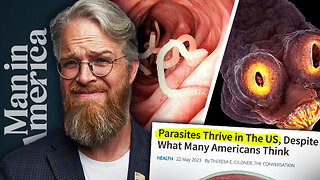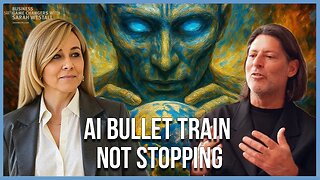Premium Only Content

Episode 3102: Clothed with Power from on High - Morning Episode
Nightly Zoom Coordinates for Rosary:
Meeting ID: 865 8978 0399
Passcode: Wjjv4960!
Speak Lord for your Servant is Listening
Book Recommendation of the Day
"Ad Caeli Reginam" (Encyclical by Pope Pius XII) – 1954
• This is the official Church document that established the Feast of the Queenship of Mary.
• Rich in theological explanation and traditional Church teaching.
The Forgotten Cross: How the Modern Church Has Traded Sanctity for Sentimentality
From the earliest days of the Church, Catholics have understood one truth with crystal clarity: the old man must be crucified daily. This teaching, rooted in Sacred Scripture and echoed by the saints throughout the ages, was once at the heart of every sermon, every liturgy, every spiritual work. St. Paul writes in Romans 6:6:
“Knowing this, that our old man is crucified with him, that the body of sin may be destroyed, to the end that we may serve sin no longer.”
This daily crucifixion of the flesh of our disordered passions, our pride, our worldly attachments was understood to be the narrow road that leads to sanctity. The Church, as Mother and Teacher, never offered a gospel of comfort or emotional satisfaction, but a Gospel of the Cross, modeled after Her Divine Spouse, Jesus Christ. She called souls to holiness, to penance, to mortification, and to the purification that comes only through suffering united with Christ.
The Abandonment of the Cross
But something changed after the Second Vatican Council. Though the Council documents themselves do not explicitly deny this truth, the spirit of Vatican II, fueled by a desire to modernize and "open the windows" to the world, brought with it a subtle but dangerous shift. The crucifix was quietly replaced in many churches with a resurrected Christ. Penitential disciplines were softened or abolished. Sermons once filled with reminders of sin, judgment, and the need for daily conversion became homilies of self-esteem, inclusion, and comfort.
The modern Catholic Church often presents itself not as the ark of salvation but as a therapeutic community. The goal is no longer sanctity, but happiness; not the Cross, but contentment; not the mortification of the flesh, but the affirmation of feelings. We now speak more of mental health than moral health, more of dialogue than doctrine, and more of accompaniment than amendment of life.
But in doing so, we have betrayed the saints and the countless martyrs who crucified the old man, not only in thought but in their very bodies. St. John Vianney, St. Teresa of Avila, St. Ignatius of Loyola, and St. Padre Pio none of them would have recognized this modern version of Catholicism that is allergic to suffering and hostile to hard truths.
The Church’s Real Mission: Sanctification
The true mission of the Church is not to make men happy in this world, but to make them saints for the next. Christ did not come to affirm us in our fallen nature, but to call us to conversion, to carry our cross, and to die to self daily. As Our Lord said:
“If any man will come after me, let him deny himself, and take up his cross daily, and follow me.” (Luke 9:23)
A Church that no longer preaches the necessity of crucifying the old man is no longer preaching Christ. It is preaching a counterfeit gospel, one that pleases the world but cannot save souls.
A Call to Return
We must return to the forgotten wisdom of the Church of all ages. We must once again proclaim that sanctity comes through suffering, that joy is born of sacrifice, and that no soul enters Heaven without first dying to self.
Let us not seek a happy Church, but a holy Church a Church that dares to teach her children that the path to eternal life runs straight through Calvary.
As St. Louis de Montfort wrote:
“No cross, what a cross!”
May we embrace the Cross anew and crucify the old man daily, so that Christ may live in us. For only in dying with Him, shall we rise with Him.
"Clothed with Power from on High: Living Between Ascension and Pentecost"
Saturday after the Fifth Sunday after Easter
Scripture Readings (1962/St. Andrew Missal)
Epistle – Romans 6:3–11
"Brethren: Know you not that all we, who are baptized in Christ Jesus, are baptized in His death? For we are buried together with Him by baptism unto death: that as Christ is risen from the dead by the glory of the Father, so we also may walk in newness of life... For in that He died to sin, He died once: but in that He liveth, He liveth unto God. So do you also reckon, that you are dead to sin, but alive unto God, in Christ Jesus our Lord."
Reflection on the Epistle – Romans 6:3–11
St. Paul draws us into the mystery of the Christian life: to be baptized is to be buried with Christ. Baptism isn’t merely symbolic it is a death to sin and rebirth into divine life. From a traditional Catholic view, this reminds us of the seriousness of the Christian vocation: to live in Christ is to live against sin and the world.
In these days between the Ascension and Pentecost, we meditate on being transformed by grace, awaiting the fire of the Holy Ghost. We live in hope and vigilance, but also in struggle the old man must be crucified daily through penance, mortification, and sacramental confession.
Quote – St. Leo the Great:
“Christian, recognize your dignity, and now that you share in God’s own nature, do not return to your former base condition by sinning.”
Gospel – Mark 16:14–20 (used during the Ascension Octave)
"At length He appeared to the eleven as they were at table: and He upbraided them with their incredulity and hardness of heart... And He said to them: Go ye into the whole world, and preach the gospel to every creature... And after the Lord Jesus had spoken to them, He was taken up into heaven and sitteth on the right hand of God. But they going forth preached everywhere: the Lord working withal, and confirming the word with signs that followed."
Reflection on the Gospel – Mark 16:14–20
This Gospel tells of Our Lord’s last words before ascending into Heaven. After rebuking His Apostles for their lack of faith, He sends them forth to preach and confirms their mission with miracles. Christ then ascends to the right hand of the Father not to leave us, but to reign over His Mystical Body, the Church.
This passage affirms both the apostolic authority and the missionary character of the Church. It also foreshadows Pentecost: the Apostles did not go out immediately, but waited in the Cenacle until they were clothed with power from on high.
From a traditional perspective, this Gospel highlights the harmony of obedience, mission, and divine grace. The Apostles didn’t invent their message they received it and were sent with authority. Likewise, our lives must conform to the deposit of faith, not modern reinterpretations.
Quote – St. Gregory the Great:
“The proof of love is in the works. Where love exists, it works great things.”
Traditional Feast Day – May 31, 2025
St. Petronilla, Virgin (1st Century) – Traditional Roman Calendar
• Considered a daughter (or spiritual daughter) of St. Peter.
• A model of virginity, piety, and fidelity to the Apostolic Church.
• Her relics were once held in the Vatican and became a powerful symbol for the Christian identity of early Rome.
"Blessed are the pure in heart: for they shall see God." – Matthew 5:8
In recent years, modern liturgical calendars have moved the Feast of the Visitation of Our Lady to May 31, but traditionally, that feast was on July 2. We remain with the older form preserved in the St. Andrew Missal.
Themes for Meditation
• Death to Sin, Life in Christ: Baptism unites us to the Cross and Resurrection.
• Apostolic Authority: The Church has a divine mandate; it does not evolve according to culture.
• The Time Between: Like the Apostles after the Ascension, we wait with longing for the Holy Ghost.
• Virginity and Apostolic Piety: Through saints like Petronilla, we see the power of hidden sanctity.
Conclusionary Prayer
Prayer Between Ascension and Pentecost
(Traditional Style):
O King of Glory, Lord of Hosts, who didst this day ascend in triumph far above all heavens:
leave us not orphans, but send unto us the Spirit of Truth, promised by the Father.
Kindle in our hearts a burning desire for holiness and apostolic zeal.
May we, like Saint Petronilla, live in purity and obedience to Thy will.
Strengthen Thy Church, guard her teachings, and sanctify her children.
Come, O Holy Ghost, and renew the face of the earth. Through Christ Our Lord. Amen.
Closing Message:
Thank you for joining us today as we meditated on the great mysteries of our faith between the Ascension and Pentecost. Remain in prayer, rooted in the sacraments, and faithful to the teachings handed down through Holy Tradition.
-
 LIVE
LIVE
Lofi Girl
2 years agoSynthwave Radio 🌌 - beats to chill/game to
361 watching -
 1:45:43
1:45:43
Man in America
15 hours agoThe DISTURBING Truth About Parasites — Live Q&A w/ Dr. Jason Dean
76.1K39 -
 7:13:47
7:13:47
SpartakusLIVE
11 hours ago#1 Mountain of Muscle with HUGE Legs saves your weekend from complete BOREDOMNight HYPE
45.3K1 -
 47:42
47:42
Sarah Westall
12 hours agoFreedom or Slavery? AI will Change Everything w/ Trump Senior Advisor Marc Beckman
61.7K14 -
 2:23:20
2:23:20
vivafrei
19 hours agoEp. 285: Visa Revocation No-Go! Sortor Arrested! Ostrich Crisis! 2A Win! Comey Defense & MORE!
119K116 -
 5:55:11
5:55:11
CassaiyanGaming
9 hours ago🟢LIVE - VISITING GOOB LAGOON! - Will They Rip Me Off?!? Waterpark Simulator
44.1K4 -
 5:42:21
5:42:21
EricJohnPizzaArtist
6 days agoAwesome Sauce PIZZA ART LIVE Ep. #64: Robbie “The Fire” Bernstein
49.9K2 -
 2:23:58
2:23:58
Nerdrotic
12 hours ago $20.65 earnedDeDunking the Debunkers with Dan Richards | Forbidden Frontier #119
64.5K15 -
 5:37:53
5:37:53
SlinderPigCamz
10 hours ago $2.16 earnedThe Headliners and other games W/GrinchyGamer101 (Road to 500 Followers)
27.1K -
 11:10:20
11:10:20
MrOldFart
14 hours ago $7.40 earnedLIVE - MEGABONK First Playthrough - Mr.OldFart
35.9K
